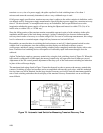105
The power supply will perform within its load effect specification at any rated output voltage combined with
any rated input line voltage.
CV PARD (Ripple and Noise)
Definition: The term PARD replaces the former term ripple and noise. PARD is the Periodic and Random
Deviation of the dc output voltage from its average value, over a specified bandwidth and with all other
parameters maintained constant.
The PARD measurement of an Agilent constant voltage power supply can be made at any input ac line voltage
combined with any dc output voltage and load current within rating. PARD is measured in rms and/or
peak-to-peak values over a 20Hz to 20MHz bandwidth. Fluctuations below the lower frequency limit are treated
as drift.
The peak-to-peak measurement is particularly important for applications where noise spikes could be
detrimental to a sensitive load, such as logic circuitry. The rms measurement is not an ideal representation of
the noise, since fairly high output noise spikes of short duration could be present in the ripple and not
appreciably increase the rms value.
The technique used to measure high frequency noise or "spikes" on the output of a power supply is more critical
than the low frequency ripple and noise measurement technique; therefore the former is discussed separately.
Figure 72A shows an incorrect method of measuring PARD, because a continuous ground loop exists, as
illustrated by the dashed line. Any ground current circulating in this loop as a result of the difference in
potential EG between the two ground points causes an IR drop which is in series with the scope input. This IR
drop has a 60Hz line frequency fundamental, and is magnified by pickup on the unshielded leads
interconnecting the power supply and scope. The magnitude of this resulting noise signal can easily be much
greater than the true power supply ripple and can completely invalidate the measurement.
The same ground current and pickup problems can exist if an rms voltmeter is substituted in place of the
oscilloscope in Figure 72. However, the oscilloscope display, unlike the true rms meter reading, tells the
observer immediately whether the fundamental period of the signal displayed is one-half cycle or one full cycle
of the ac input. Since the fundamental ripple frequency present on the output of an Agilent supply is 2f
L
, where
f
L
is the line frequency (due to fullwave rectification), an oscilloscope display showing a 2f
L
fundamental
component is indicative of a "clean" measurement setup, while the presence of a fundamental frequency f
L
usually means that an improved setup will result in a more accurate (and lower) value of measured ripple.
Figure 72B shows a correct method of measuring the output ripple of a constant voltage power supply using a
single-ended scope. The ground loop path is broken by floating the power supply output. Note that to ensure
that no difference of potential exists between the supply and the scope, it is recommended that they both be
plugged into the same ac power buss whenever possible. If the same bus cannot be used, both ac grounds must
be at earth ground potential.


















